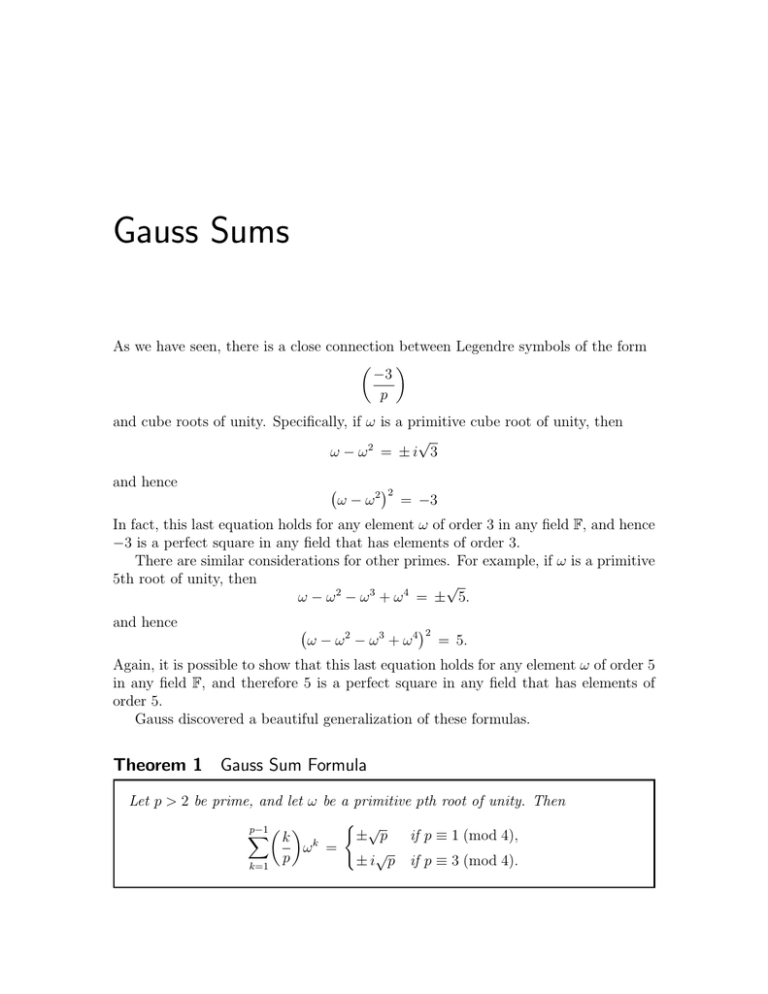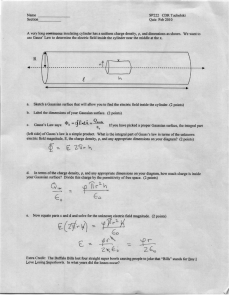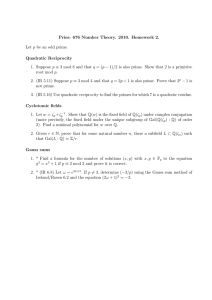Gauss Sums
advertisement

Gauss Sums
As we have seen, there is a close connection between Legendre symbols of the form
−3
p
and cube roots of unity. Specifically, if ω is a primitive cube root of unity, then
√
ω − ω2 = ± i 3
and hence
ω − ω2
2
= −3
In fact, this last equation holds for any element ω of order 3 in any field F, and hence
−3 is a perfect square in any field that has elements of order 3.
There are similar considerations for other primes. For example, if ω is a primitive
5th root of unity, then
√
ω − ω 2 − ω 3 + ω 4 = ± 5.
and hence
ω − ω2 − ω3 + ω4
2
= 5.
Again, it is possible to show that this last equation holds for any element ω of order 5
in any field F, and therefore 5 is a perfect square in any field that has elements of
order 5.
Gauss discovered a beautiful generalization of these formulas.
Theorem 1 Gauss Sum Formula
Let p > 2 be prime, and let ω be a primitive pth root of unity. Then
( √
p−1 X
± p
if p ≡ 1 (mod 4),
k
ωk =
√
p
± i p if p ≡ 3 (mod 4).
k=1
Gauss Sums
2
The sum
p−1 X
2 2
3 3
p − 1 p−1
k
k
ω = ω+
ω +
ω + ··· +
ω
gp (ω) =
p
p
p
p
k=1
is known as a Gauss sum. According to the theorem
(
p if p ≡ 1 (mod 4),
gp (ω)2 =
−p if p ≡ 3 (mod 4),
for any primitive pth root of unity ω. Equivalently, we can write this formula as
−1
2
p.
gp (ω) =
p
EXAMPLE 1 Gauss Sum for p = 7
It is easy to check that the quadratic residues modulo 7 are {1, 2, 4}, while {3, 5, 6}
are quadratic non-residues. Therefore, by the Gauss sum formula
√
ω + ω2 − ω3 + ω4 − ω5 − ω6 = ± i 7
for any primitive 7th root of unity ω.
It is not too hard to check that this is correct. Squaring the Gauss sum gives
ω + ω2 − ω3 + ω4 − ω5 − ω6
2
= ω 2 + 2ω 3 − ω 4 + ω 6 − 6ω 7 + ω 8 − ω 10 + 2ω 11 + ω 12
and using the identity ω 7 = 1 to reduce the powers of ω simplifies this to
2
ω + ω 2 − ω 3 + ω 4 − ω 5 − ω 6 = −6 + ω + ω 2 + ω 3 + ω 4 + ω 5 + ω 6 .
But 1 + ω + ω 2 + ω 3 + ω 4 + ω 5 + ω 6 = Φ7 (ω) = 0, and hence
ω + ω2 − ω3 + ω4 − ω5 − ω6
2
= −7.
EXAMPLE 2 Gauss Sum for p = 11
It is easy to check that the quadratic residues modulo 11 are {1, 3, 4, 5, 9}, while
{2, 6, 7, 8, 10} are quadratic non-residues. Therefore, by the Gauss sum formula
√
ω − ω 2 + ω 3 + ω 4 + ω 5 − ω 6 − ω 7 − ω 8 + ω 9 − ω 10 = ± i 11
for any primitive 11th root of unity ω.
Gauss Sums
3
Again, we can use simple algebra to show that this is correct. Squaring the Gauss
sum and applying the identity ω 11 = 1 gives the formula
2
ω − ω 2 + ω 3 + ω 4 + ω 5 − ω 6 − ω 7 − ω 8 + ω 9 − ω 10
= −10 + ω + ω 2 + ω 3 + ω 4 + ω 5 + ω 6 + ω 7 + ω 8 + ω 9 + ω 10
But 1 + ω + ω 2 + · · · + ω 10 = Φ11 (ω) = 0, and hence
ω − ω 2 + ω 3 + ω 4 + ω 5 − ω 6 − ω 7 − ω 8 + ω 9 − ω 10
2
= −11.
EXAMPLE 3 Gauss Sum for p = 13
It is easy to check that the quadratic residues modulo 13 are {1, 3, 4, 9, 10, 12}, while
{2, 5, 6, 7, 8, 11} are quadratic non-residues. Therefore, by the Gauss sum formula
√
ω − ω 2 + ω 3 + ω 4 − ω 5 − ω 6 − ω 7 − ω 8 + ω 9 + ω 10 − ω 11 + ω 12 = ± 13
for any primitive 13th root of unity ω.
Since 13 ≡ 1 (mod 4), the algebra for checking this goes a little differently.
Squaring the Gauss sum and then reducing powers of ω modulo 13 gives
2
ω − ω 2 + ω 3 + ω 4 − ω 5 − ω 6 − ω 7 − ω 8 + ω 9 + ω 10 − ω 11 + ω 12
= 12 − ω − ω 2 − ω 3 − ω 4 − ω 5 − ω 6 − ω 7 − ω 8 − ω 9 − ω 10 − ω 11 − ω 12 .
But 1 + ω + ω 2 + · · · + ω 12 = Φ13 (ω) = 0, and hence
ω − ω 2 + ω 3 + ω 4 − ω 5 − ω 6 − ω 7 − ω 8 + ω 9 + ω 10 − ω 11 + ω 12
2
= 13.
Of course, the Gauss sum formula gives two possible values of gp (ω) in each case, so
a natural question to ask is which of these two values gp (ω) is equal to. For example,
√
√
if p ≡ 1 (mod 4), is gp (ω) equal to p or − p. The answer is that it depends on
which primitive pth root of unity ω we choose. However, in the case where ω = e2πi/p ,
Gauss was able to prove that
(√
p if p ≡ 1 (mod 4),
gp (ω) =
√
i p if p ≡ 3 (mod 4).
For example, if ω = e2πi/7 then
√
ω + ω 2 − ω 3 + ω 4 − ω 5 − ω 6 = i 7,
and if ω = e2πi/13 then
ω − ω 2 + ω 3 + ω 4 − ω 5 − ω 6 − ω 7 − ω 8 + ω 9 + ω 10 − ω 11 + ω 12 =
√
13.
This result is actually much more difficult than the Gauss sum formula, and we will
not prove it here.
Gauss Sums
4
Proof of the Gauss Sum Formula
Throughout this section, let p > 2 be a prime, and let ω be a primitive pth root of
unity. Let gp (x) be the Gauss polynomial
p−1 X
k k
gp (x) =
x .
p
k=1
Our goal is to prove that
2
gp (ω) =
−1
p.
p
Extension of the Legendre Symbol
For convenience, we will use the convention that
a
= 0 if p | a.
p
Using this notation,
p−1 X
k k
x ,
gp (x) =
p
k=0
where the sum starts at k = 0 instead of k = 1.
Squaring the Gauss Sum
Observe first that
p−1 p−1 X
X j
k
gp (ω) =
ω j+k .
p
p
j=0 k=0
2
Since ω p = 1, we can reduce each power of ω modulo p and then combine like terms.
This yields an equation of the form
where
gp (ω)2 = a0 + a1 ω + a2 ω 2 + · · · + ap−1 ω p−1
(1)
X j k an =
p
p
j+k ≡ n
(2)
(mod p)
for each n ∈ Zp .
Gauss Sums
5
Sum of the Coefficients
Note first that
gp (1) =
p−1 X
k
k=1
p
= 0
Z×
p
has an equal number of quadratic residues and quadratic non-residues. It
since
follows that gp (1)2 = 0, so the sum of the coefficients in gp (x)2 is equal to 0. Therefore,
a0 + a1 + · · · + ap−1 = 0.
(3)
Value of a0
It is not hard to determine the value of a0 . By equation (2), we have
p−1 X j k X
j
−j
a0 =
=
.
p
p
p
p
j=0
j+k ≡ 0
(mod p)
But
2 if j = 0,
0
−j
j
−1
j
=
=
−1
p
p
p
p
otherwise.
p
and thus
a0 =
p−1 X
−1
p
j=1
=
−1
(p − 1).
p
(4)
Equality of the Remaining Coefficients
Let n ∈ Z×
p . By equation (2), we have that
X j k an =
.
p
p
j+k ≡ n
(mod p)
If we make the substitution j = nj 0 and k = nk 0 , then j 0 + k 0 ≡ 1 (mod p), and indeed
X nj 0 nk 0 an =
.
p
p
0
0
j +k ≡ 1
(mod p)
But
nj 0
p
nk 0
p
=
n2
p
0 0 0 0 j
k
j
k
=
p
p
p
p
Gauss Sums
and hence
6
X j 0 k 0 = a1
an =
p
p
0
0
j +k ≡ 1
(mod p)
for all n ∈ {1, . . . , p − 1}. Thus
a1 = a2 = · · · = ap−1 .
(5)
End of the Proof
Equations (3) and (5) are
a0 + a1 + · · · + ap−1 = 0
and
a1 = a2 = · · · = ap−1
and combining these together gives
an = −
a0
p−1
for each n ∈ {1, . . . , p − 1}. Substituting in the value of a1 obtained in (4), we deduce
that
−1
an = −
p
for each n ∈ {1, . . . , p − 1}. Thus equation (1) becomes
−1
2
gp (ω) =
(p − 1) − ω − ω 2 − · · · − ω p−1 .
p
But
1 + ω + ω 2 + · · · + ω p−1 = Φp (ω) = 0
so
ω + ω 2 + · · · + ω p−1 = −1.
and hence
2
gp (ω) =
−1
p.
p
This completes the proof of the Gauss sum formula.
Gauss Sums
7
Symmetry of Gauss Sums
The Gauss sum formula tells us that
2
gp (ω) =
−1
p
for any primitive pth root of unity ω. The following formula tells us how the sign of
gp (ω) changes when we use different pth roots of unity.
Proposition 2 Symmetry of the Gauss Sum
Let p > 2 be a prime, let ω be a primitive pth root of unity, and let
p−1 X
k k
gp (x) =
x .
p
k=1
Then for each n ∈ {1, . . . , p − 1},
n
gp (ω ) =
gp (ω).
p
n
PROOF Observe that
X
p−1 p−1 X
n
nk nk
k nk
gp (ω ) =
x =
x .
p
p
p
k=1
k=1
n
But as k runs over the set {1, . . . , p − 1}, the product m = nk also runs over the
elements of this set. Hence we can substitute m = nk to get
X
p−1 n
m m
n
gp (ω ) =
x =
gp (ω).
p m=1 p
p
n
EXAMPLE 4
Consider the polynomial
g7 (x) = x + x2 + x4 − x3 − x5 − x6 .
If ω = e2πi/7 , then it is easy to check that
√
g7 (ω) = ω + ω 2 + ω 4 − ω 3 − ω 5 − ω 6 = i 7.
Gauss Sums
8
According to the formula above, it follows that
n √
n
n
g7 (ω) =
i 7
g7 ω =
p
p
for any n ∈ Z×
p . For example,
2
4
3
5
6
g7 ω 2 = ω 2 + ω 2 + ω 2 − ω 2 − ω 2 − ω 2
= ω2 + ω4 +
ω
√
− ω 6 − ω 3 − ω 5 = g7 (ω) = i 7
since 2 is a quadratic residue modulo 7, and
6
5
3
4
2
g7 ω 3 = ω 3 + ω 3 + ω 3 − ω 3 − ω 3 − ω 3
= ω3 + ω6 + ω5 − ω2 −
since 3 is a quadratic non-residue modulo 7.
ω
√
− ω 4 = −g7 (ω) = −i 7



